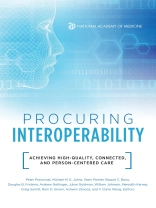Realizing the promise of digital technology will depend on the ability to share information across time and space from multiple devices, sources, systems, and organizations. The major barrier to progress is not technical; rather, it is in the failure of organizational demand and purchasing requirements. In contrast to many other industries, the purchasers of health care technologies have not marshaled their purchasing power to drive interoperability as a key requirement. Better procurement practices, supported by compatible interoperability platforms and architecture, will allow for better, safer patient care; reduced administrative workload for clinicians; protection from cybersecurity attacks; and significant financial savings across multiple markets.
With funding support from the Gordon & Betty Moore Foundation, this National Academy of Medicine Special Publication represents a multi-stakeholder exploration of the path toward achieving large-scale interoperability through strategic acquisition of health IT solutions and devices. In this publication, data exchanges over three environments are identified as critical to achieving interoperability: facility-to-facility (macro-tier); intra-facility (meso-tier); and at point-of-care (micro-tier). The publication further identifies the key characteristics of information exchange involved in health and health care, the nature of the requirements for functional interoperability in care processes, the mapping of those requirements into prevailing contracting practices, the specification of the steps necessary to achieve system-wide interoperability, and the proposal of a roadmap for using procurement specifications to engage those steps. The publication concludes with a series of checklists to be used by health care organizations and other stakeholders to accelerate progress in achieving system-wide interoperability.
ABOUT THE NATIONAL ACADEMY OF MEDICINE
Founded in 1970 as the Institute of Medicine, the National Academy of Medicine (NAM) is one of three academies constituting the National Academies of Sciences, Engineering, and Medicine (the National Academies). The National Academies provide independent, objective analysis and advice to the nation and conduct other activities to solve complex problems and inform public policy decisions. The National Academies also encourage education and research, recognize outstanding contributions to knowledge, and increase public understanding in matters of science, engineering, and medicine.
قائمة المحتويات
Foreword xv
Preface xix
Executive Summary 1
I. Why Interoperability is Essential in Health Care 5
II. Interoperability in the Health Ecosystem 15
III. Interoperability Procurement Specification Strategies 31
IV. Transforming the Health IT Marketplace 41
V. Perspectives on the Issue: An NAM Public Symposium 53
VI. Procurement Implementation: Action Checklist 65
REFERENCES 71
APPENDIXES
Appendix A. Procuring Interoperability: Technical Supplement 75
References 135
Appendix B. NAM stakeholder meeting agenda and participants 139
Appendix C. Biographies of steering committee members and staff 151
Appendix D. Glossary, initialisms and abbreviations 161












